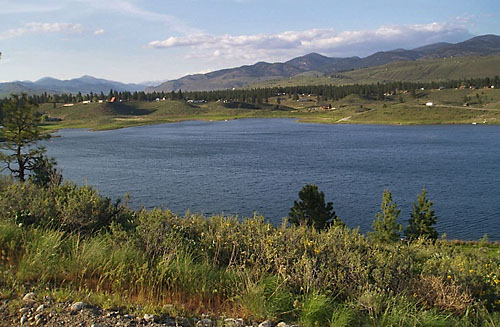home | internet service | web design | business directory | bulletin board | advertise | events calendar | contact | weather | cams

|
 Looking north over Big Twin Lake outside of Winthrop. Notice the kames - the gravel humps - on the far shore. Photo by Tucker Barksdale Looking north over Big Twin Lake outside of Winthrop. Notice the kames - the gravel humps - on the far shore. Photo by Tucker Barksdale
Big and Little Twin lakes Driving or pedaling along the Twin Lakes Road west of the high school with an eye out for deer, the traveler might catch a glimpse of an eagle perched on a snag or fishermen after lunker trout in Big Twin Lake. Park along the road though, and take a closer look. The road and the flats and gravel hills of the Twin Lakes Ranch development sit above the mostly circular lake. Unlike most of the Methow’s mountain and valley lakes, there are no creeks feeding or draining either Big or Little Twin. The Methow has been covered by glacial ice several times in the last two million years. The most recent advance started with several miles of accumulated snow pressed into ice in British Columbia. The ice moved south and over the valley reaching a maximum extent about 15,000 years ago. The ice sheet topped Goat Peak near Mazama and left evidence high on Billy Goat Mountain by Pateros. It looked like today’s aerial photos of the Antarctic or Greenland ice caps. Just a few ragged peaks stood above a sea of ice. Under the ice sheet existing valleys were deepened and dividing ridges were smoothed.  Small kettle by the boat launch between Big Twin Lake and LIttle Twin Lake. Picture a large chunk of leftover ice surrounded by gravel deposited around it as the rest of the ice melted, and leaving this depression when the chunk was the last to melt. Photo by Tucker Barksdale Small kettle by the boat launch between Big Twin Lake and LIttle Twin Lake. Picture a large chunk of leftover ice surrounded by gravel deposited around it as the rest of the ice melted, and leaving this depression when the chunk was the last to melt. Photo by Tucker Barksdale
Weather patterns changed and the heavy snows to the north diminished. No longer fed by precipitation, the ice sheet slowed and came to a stop. A temperate climate now had the advantage. Melting ate rapidly at the massive ice sheet. The ice melted away from the sides of the valley and huge torrents of melt water filled the void carrying debris from the melting ice. The once solid ice sheet broke into pieces with muddy rivers flowing between them.
In the Twin Lakes area, massive blocks of ice sat like bergs surrounded by deposited sand, gravel and boulders. The melting of these remnants may have taken 3,000 years as the rivers flowing around them slowed. In the end, depressions called kettles were left as the ice melted in the gravel. The largest pieces left kettles deep enough to expose the ground water - kettles like where Big and Little Twin lakes now sit. Around the Twin Lakes Ranch development there are many smaller kettles and rolling gravel hills that make steep-sided depressions. Geologists call this kame and kettle topography. The next time you see Big Twin Lake picture the huge block of ice melting and leaving the water-filled evidence of its glacial past. 6/4/2012 Comments
|